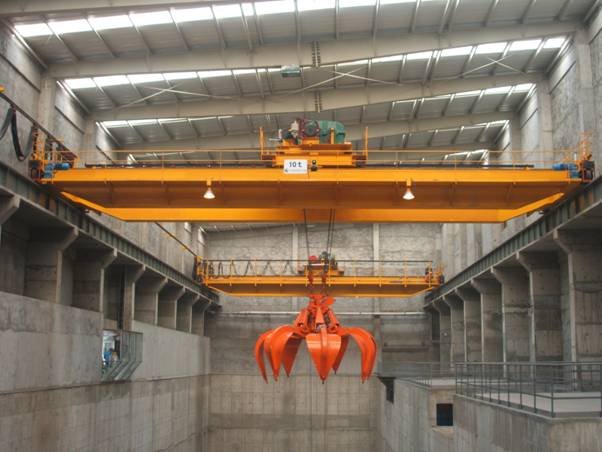<p>Overhead cranes are more commonly and certainly appropriately, based on their appearance known as “bridge cranes.” These powerful, heavy-duty machines differ from “gantry” or goliath cranes in that they do not stand on two or more legs affixed to a ground level rail. Rather, overhead cranes are, as their more official name implies, overhead; usually within an industrial environment, a “bridge” spans the gap between two parallel runways above workers’ heads. The “hoist,” or the part of the overhead crane that performs the lifting, moves heavy materials by using those runways as support while travelling along the length of the bridge.<br />
This particular type of crane can most often be found shifting enormous loads for the steel industry. Nearly every step within this industry, which demands massive, dangerous materials to be moved swiftly yet accurately, involves an<br />
<strong>Overhead Crane:</strong> an overhead crane pours the raw materials into the furnace, stores the resultant hot steel until it is cool, and then loads the finished products onto whatever will transport the steel to its next destination. For similar reasons, the automobile industry is also a frequent employer of the overhead crane.<br />
<strong>How do I safely work an overhead crane?</strong><br />
Despite their great value for industries that need to frequently move heavy materials, overhead cranes are expensive and potentially dangerous machines (if in the hands of an inexperienced operator). Understanding the safety procedures involved in operating an overhead crane is essential. These procedures can be broken down into five basic steps.</p>
<ul>
<li>The first is to learn the crane’s load capacity. No attempt should ever be made to force the crane to life a load greater than its rated load capacity; such a situation risks serious injury and irreparable damage to the crane. Part of understanding the crane’s load capacity is to test that the crane is also able to currently meet this fundamental level of functioning: This is done by simply testing the hoist brakes. If these brakes do not perform effectively, stop immediately, slowly lower the hoist, and do not attempt to operate the machinery again until it has been repaired.</li>
<li>The second step is similarly related to pre-operation inspection. All the equipment and inner workings of the overhead crane should be inspected on a daily basis; if anything appears in disrepair at any point, operation should immediately stop. Specifically, this inspection can be swiftly but effectively carried out by checking for any leaks near pneumatic or hydraulic parts, testing the crane’s movement to ensure it moves smoothly in all directions, and listening for any strange sounds as it operates. As with any industrial piece of equipment, worn parts should of course be immediately replaced.</li>
<li>The third step involves checking over the surrounding area. Before any load is lifted, any loose materials must be stabilized. Additionally, the sling and ropes used to hoist the load should be taught; any unaccounted for slack may cause the load to be suddenly jarred or shifted. The lifting device must be securely fitted in the saddle of the overhead crane’s hook, and workers should be clear of the site so any risk of a falling item harming someone is eliminated.</li>
<li>On a related note, the fourth step is to develop a familiarity with the surrounding area. Identify any critical locations related to the crane’s controls, and ensure those areas can be quickly and easily accessed. This includes knowing exactly how to stop the crane in case of an emergency; typically, this can be immediately accomplished via a disconnect switch (which should always be close by and carefully maintained). All controls should be well understood by workers and clearly marked in a way that allows anyone to understand their function.</li>
<li>Finally, although the previous steps should prevent any such situation, the fifth step is to prepare for the worst-case scenario. Every worker on the site should be familiar with emergency procedures. These procedures should cover the full spectrum of negative possibilities, whether the failure is electrical or mechanical in nature. The tools and accessibility needed to rescue an operator from a cab must always be available as well, and all cabs should be obligated to have a fire extinguisher.</li>
</ul>
<p><strong>What training do I need to operate an overhead crane? </strong><br />
The Occupational Safety and Health Administration (OSHA) has set multiple regulations in place to ensure the safety procedures discussed above are enforced within the workplace. As these regulations are implemented through the federal government, it is critical any individual seeking to operate an overhead crane is properly educated. Generally, it is the responsibility of the employer to ensure each worker knows how to deal with the potential hazards of the workplace.</p>
<h5>Featured images:</h5>
<ul>
<li> <span class="license">License: Creative Commons</span> <span class="source">image source</span></li>
</ul>
<p>Lisa Ann writes on behalf of R&;d Ergo, a company which deals in cranes &#8211; overhead power lines.</p>

Overhead Cranes: Description, Safety Procedures, And Regulations
